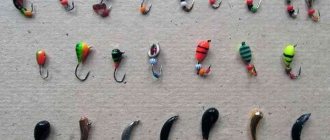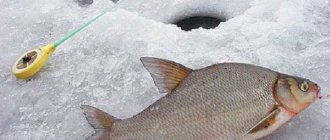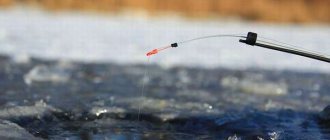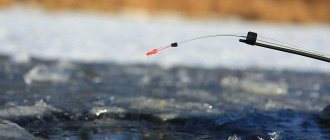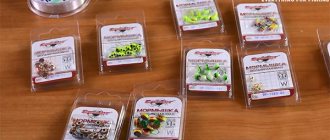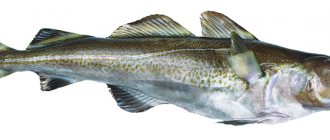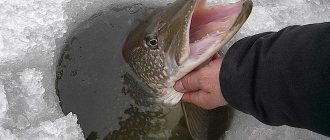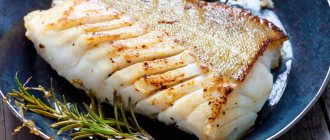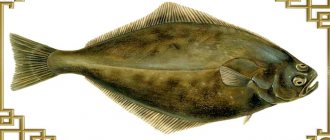For fans of baitless fishing, reelless jigs are the last piece of gear that directly forces the fish to grab the hook. There are no bloodworms on a reelless bait, and the success of fishing depends on the correct choice of jig, as well as attractive play with bait. In this article we will look at the most catchy baitless jigs, features and nuances of use.
Fishing with reelless jigs
Beginners often make the mistake of starting their journey in baitless fishing by chasing the “most efficient” and most catchy jig. The main thing in winter fishing with jigs without moths is to adhere to the basic principles, which differ from standard fishing with the addition of bloodworms. To begin with, you master the correct game using standard jigs, and understand the characteristics of the tackle and fish bite. Read more about this in a special article:
Fishing without a bait in a current differs from fishing in still water; different tactics are used on a reservoir than on a small river. The equipment of a fishing rod is specific, and the wrong approach to this issue is unlikely to bring a bite. An article about winter reelless fishing rods. Only after understanding the basics and mastering a few simple baitless jigs for winter fishing should an angler dive deeper into the vast world of these lures. You can only find the best reelless bait by acquiring fishing experience on a pond. There is not a single universal model - only in certain fishing conditions, for a specific type of fish and using the right game.
The main law of no-bait is a balanced rig, matching line, nod and reel, as well as monotonous play without failures. These features and nuances are discussed in detail using the links provided. In this article we will look at what a reelless jig is and what types of nozzle jigs there are.
Mothless without a nod
Why no nod? – you ask, there have been debates on this subject for a long time, someone claims that in the absence of a nod, the bite is felt immediately in the hand, thereby increasing the speed of reaction to the bite (this is only one of the advantages).
For example, when fishing with a reelless bait with a nod, when hooking, several centimeters are formed, the so-called free play when hooking, and during this time the fish can spit out the bait; in the option without a nod, an instant hook occurs, which significantly reduces the number of idle bites .
The length of the rod's whip is quite large and reaches 30 cm. +/-5 cm - this makes it possible to do less work with your hand, and not shake “with your whole body ,” but work only with your hand.
Another advantage of a fishing rod without a nod is the plasticity of the whip, which ensures confident fishing and almost absolute safety of the jigs. It is worth noting here that the whip does not act as a nod and does not register the bite of the fish, but bends under its suspenders. This fishing rod also does not sink in water and is very compact.
There are, of course, disadvantages to this gear. When fishing, your fingers should be open to ensure direct contact with the rod in order to increase sensitivity. But from my own experience I will say that this is not a problem when using a jacket with protruding sleeves such as Buran and mitten gloves. I fished at -30 and felt quite comfortable. And if you fish in a tent, your hands don’t get cold at all.
One of the conditions for good sensitivity of this gear is its lightness . However, I find this condition to be a significant drawback when landing fish from great depths. Throwing the fishing rod to the side, due to its lightness, it can be caught by the wind and fly back, or slip along the ice into the already folded loops of the fishing line. Then entanglement is guaranteed. Winding fishing line onto a miniature spool also causes difficulties, for example, if you run all day and look for fish at long distances between holes.
But I usually don’t run after fish, but rather fish in a certain area with a distance between holes of a maximum of 20 meters. In such conditions, there is no need to reel in the line, but just take the jig and drag the fishing rod through the snow by the line, here its lightness plays into your hands!
The point is to find a hole in which the bream will bite without bait, and only then feed it. The advantages of this gear when searching for bream are obvious: the use of a balalaika ensures quick reeling of fishing line from great depths, and a large jig is audible to fish from a long distance.
Fishing rods are made from aviation foam for the spool and carbon whips for feeder rods. 2 whips come out of one whip.
The fishing line at the tip of the whip is fixed with silicone cambric , through which it slides under tension. (Cambrics made from other materials quickly fray).
I separate all the fishing rods as in spinning fishing, each has its own weight range of jigs used, regardless of their type, be it a devil, an ant, a nymph, etc. I start building the tackle with the weight of the jig, and select a fishing line for the jig. According to the classics: the line should be pulled into a straight line under the weight of the jig.
Next, I select the working flexibility and length of the whip, which is found experimentally (by playing in a jar of water). Then, depending on the diameter of the fishing line and the weight of the jig, I choose the diameter of the spool, which I make in two sizes (Height/Width of the large radius/Width of the small radius, cm.) 3/2.5/2 and 4/3.5/3.
I cover the fishing rods with nail polish for better fishing line glide, and I glue the whip with superglue.
For example, for jigs weighing 0.2-0.25 g. The fishing rod is equipped with a 0.06 mm fishing line, a 30 cm long whip and a small spool. The total weight of the tackle with wound fishing line is 2 grams. Works well at a depth of up to 5 meters. Ideal for catching small fish (for example, bleak) up to 150 g. on ponds, shallow bays and in the coastal part of reservoirs.
The next set is mainly for catching roach from 70 to 200 gr. weight: jig 0.4-0.45 g, fishing line 0.08 mm.
Then the most popular set for catching perch , large roach and small bream: jigs 0.5-0.55 g, fishing line 0.1 mm.
And a purely set for bream , sometimes a rather large roach, zander and squint fly in: jigs 0.6-0.65 g, fishing line 0.12 mm, large spool. Works at depths of up to 13-15 meters.
I divide jigs into 2 types: devils and regular jigs with one hook. The single-hook model is not so important, but the method of equipment is more significant. My assortment is not large, but it is varied in the range of vibrations produced. It includes: cambrics, small beads, large beads, small wing, large wing.
I have one rule
Everything else is intermediate combinations to achieve the best result. It often happens that with one type of jig the bite in the hole ends, but when using another, there are bites again. It is very beneficial to use this when fishing on a baited hole in a tent, especially if a strong wind is blowing and there is no desire to run through bad weather in search of active fish in additionally baited holes.
Reelless jigs
Nozzle-less jigs are a generalized category. If you hang a bead on the hook of an ordinary jig instead of a bloodworm, the bait turns into a baitless one. However, this difference is deeper than at first glance. The best reelers, when approached correctly, seduce fish that are not feeding at the moment, forcing them to bite out of curiosity. Therefore, the no-bait fisherman counts on a catch when standard gear with bait is silent. There are an endless variety of varieties, types and species of mothless moths. Every year new ones appear, offered by fishing stores or made by amateur home-made workers.
For professionals, nozzle is an exciting sporting activity. These fishermen go out to the reservoir not with the goal of catching fish, but for the sake of biting on artificial pieces of iron. In amateur fishing, baitless fishing is rather one of the methods that organically complements the entire range of fishing methods. When fishing for bream with devils, for example, it would not be amiss to attach a bunch of bloodworms to the hook after the fish approaches the point, and a non-moth gear can be used for searching or teasing.
Specifics of reelless jigs
Let's look at the difference between attachment jigs and no-reel jigs. The main difference is the purpose of application. With the addition of bloodworms, the task of the bait is to load the bait and nod, and deliver the equipment to the bottom. The biting factor is live bloodworm larvae on a hook. Therefore, color and appearance are secondary. Standard jigs often form a simple vertical suspension when tied to a fishing line, with the hook pointing down. For baitless baits, baits with a horizontal or angular suspension are more suitable, since the fish tries to grab not the hook itself, but the entire jig, perceiving the bait as a single object. A hook deflected to the side increases the likelihood of a successful hook. Different types of mothless moths are characterized by different suspension angles. The subtleties of the behavior of decoys underwater when playing depend on this parameter.
Hooks in baitless fishing are equipped with various additional elements - beads, balls, threads. Often the factor of bead color or contrast becomes decisive on a pond. At the same time, a number of jigs (for example, devils) are sometimes used without pendants at all. The features of reelless jigs depend on proper play. No matter how bright or beautiful the piece of iron is, the fish will not take it if it is wired incorrectly. The correct game is the basis of baitless fishing, and the equipment of a reelless fishing rod is secondary; working options are revealed already during the fishing process.
The Internet is full of ratings of reelless jigs. These are the machinations of marketing or advertising. You won't find the top 10 mothless fish here - it doesn't exist for fish. Each lure can be the best reelless bait for winter fishing, but only in certain hands, in certain conditions on the pond and with the right game. Let's look at what types of reelless jigs there are and the conditions for their use.
Working rewinders
How to distinguish a reelless jig from a simple jig? The simplest thing is the presence of bright artificial elements on the hook. For the first experiments, you don’t need to buy specialized reelless jigs; standard pellets, droplets, and oats will do. It is better to choose baits with a suspension to the line close to 45 degrees, and equip the hook with a pair of contrasting beads - white and black, green and red, etc. Small beads with a large hole (to fit through the beard of the hook) are more suitable. To prevent the beads from falling off, a cambric or piece of plastic is threaded through the top. An example is a Cyclops jig, essentially an ordinary washer (tablet), just an artificial eye was glued to the front surface and decorations were hung on the hook. Let's consider the working popular options for mothless machines.
Cyclops
Sausage
Mormyshka sausage is made from a metal rod cut according to the castmaster principle. Unfortunately, you rarely find this wonderful breamless reeler in the store. Fishermen often make it themselves. The sausage is distinguished by a game similar to vertical spoons - when released, it sinks, deviating a step to the side and returning to its place (due to the angular surfaces of the cuts). Application – catching bream at depth or perch using the micro-spinner principle (reelless baits cut short, but with large angles, closer to the castmaster, are suitable for this).
Long cut sausage
Short cut
Dreissen
The zebra mussel jig is shaped like a shell of the same name, which is a natural food for bream and large roach. This is a fairly large and heavy rewinder that penetrates the water layer well. Has a nodding action (due to its low center of gravity), causing the ornament hook to tilt up and down.
Dreissen
Owl
A large nozzle-less owl jig (formerly called a scoop) is more of a micro-spoon. Excellent for baitless fishing for bass, perch or pike perch. During periods of activity, it is taken by a large crucian carp or carp; this mothless fish mows down into a small fry. Thanks to its widened and curved shape, it glides and nods even at great depths.
Homemade owls
Ants, bugs and nymphs
The most popular class of mothless. These are elongated jigs with a slight bend throughout the body. Depending on the thickness, length and characteristics, they are called differently. They are positioned as resembling underwater insects from a distance. The ant has a thick head at the top, while the bug's center of gravity is in the middle (somewhat similar to the dracena). The nymph is more protruding and less arched. Each type has its own game, determined by the location of the center of gravity. An interesting option is the black widow jig, so named because of its unique coloring. This reelless jig consists of three ball joints, descending in size from the top of the jig to the hook. All these types of reelless baits are universal and catch any fish. There are hundreds of different options. A couple of nymphs and ants of different sizes and colors (such as black and silver) are a great start to learning to use wormless baits.
Nymph
Klopik
Ants
Black Widow
Goat
The peculiarity of this rewinder is the presence of two soldered hooks facing to the sides. This bait is similar in size to single-hook hooks. The mothless goat also comes in a variety of shapes and colors. The standard option is black or silver. Due to the special shape of the body, it sometimes works well without any decorations, resembling a fry in the silver version, and a beetle in the black version. Working reeler for active fish.
Goat
Banana
Bananas are slightly larger than nymphs. Roughly speaking, a banana jig is a large nymph. There are plenty of models, colors and weights. A universal rewinder that works in a variety of water bodies and conditions.
Banana
Cobra
Another type from a series of convex-bent non-rewinders for creating a planning game. The reelless cobra, depending on its size, catches any fish. As always, the key is to find the right game. Large cobras are used as micro-spoon baits.
Cobra
Uralka
A classic jig with a long body and a thickened top, gently curving towards the hook. Small uralks are suitable for roach and bream; bream in the depths and perch in the shallows do not refuse large ones. The Uralka reelless bait is another excellent universal bait for a beginner.
Uralochka
Cuttlefish
The cuttlefish is a hybrid of a cobra and a goat. The shape of the bait is similar to a cobra, and is equipped with two hooks, like a goat. Interesting model to study.
Cuttlefish
Reelless fishing technique
The technique of fishing with a reelless reel in winter is chosen depending on the environmental conditions. There are several ways to serve mothless. Each of them can become effective and produce a lot of bites. Postings when fishing:
Winter fishing with a reelless bait looks like this: drill a hole in the ice cover and make 2 lifts of the jig. The ascents must be fast. After the second rise at the top point, you need to take a short break. These postings are repeated several times if the bite does not appear. If it is completely absent, it is necessary to make another hole.
Tips for fisherman: How to catch bream with a float rod - Answers for beginners
Each angler who is interested in reeling over time develops his own fishing technique, a special grip of the fishing rod, fishing style, the ability to set and maintain a certain rhythm of the game, as well as hooking. Naturally, the fisherman begins to understand and imagine which fishing rod he is most comfortable fishing with.
Devils
It’s not for nothing that baitless jigs like devils and the like are loved by fishermen without reeling. When used skillfully, these baits become super catchy. They are quite heavy, so they are convenient for use at various depths, including currents. Some fishermen fish only with devils, not recognizing other baits. These are effective catchers for white fish and predators. Elongated devils work well on bream, round and pot-bellied ones work well on roach and perch. The main feature of the bait is its vertical weight balance.
When playing, the devil should not make parasitic horizontal oscillations; only up and down movements are permissible. The wiring animates the behavior of the amphipod bug in the water - uniform dotted movements. There are many varieties of such jigs - solid, composite, with a ring or hole through the body, with soldered hooks or hanging ones (devils, graders). The devil jig, in addition to its own movements, also chaotically throws a suspended tee when retrieving it, which works great for perch during the dry winter period.
Making a reelless reel for roach and perch with your own hands
Fishing with a winter reelless bait is not only interesting, but also effective. The active movements of such a bait arouse the interest of all inhabitants of the depths, including the laziest and most sedentary. It is the classic variety of jig, but without bait, that is called a reelless jig. With its help, various fish are successfully caught, including roach, perch and even pike.
Unlike classic fishing, when using a reelless fishing rod, the angler needs to constantly move the fishing rod, causing the bait to play in a specific way. In a stationary state, it is simply useless and does not bring any results. As for the advantages of reelless jigs for roach and perch, they are as follows:
- Maximum efficiency under any conditions and high chances of catching trophy prey.
- Increased fish activity in the absence of a bite. The bait provokes underwater inhabitants to actively attack, which is explained by its unique game and performance characteristics.
- Save time. It’s no secret that you don’t need to use bloodworms or any other bait for a reelless jig. Accordingly, the fisherman has a lot of useful time, which he can use correctly.
- The choice of movements and retrieves is incredibly wide, which increases fishing productivity. In addition, every fishing lover will have the opportunity to experiment with games and find their own style.
It is no secret that the most common inhabitant of freshwater bodies of water is the roach. It can be found in almost every river, lake and reservoir, provided that the water in the reservoir is clean and fresh, heated to the optimal temperature.
If fishing takes place on a large river with a strong current and a large layer of silt at the bottom, fish are practically not found there. When winter cold comes, it has to be taken out from the deepest points, that is, to look for various depressions, holes and other relief changes at the bottom.
You need to start searching for roach from the first days of freeze-up: feeling anxious and significantly colder, it begins to feed intensively, reacting to any bait. At the same time, good activity will please the angler almost the entire season, although at some intervals it worsens.
In any case, a reelless jig can be a good tool for activating roach even at the most unfavorable times.
Currently, the range of reelless jigs is so diverse that, regardless of the conditions in which fishing takes place, the angler will always find something effective. Models with a curved or flat-convex configuration are especially in demand. If the tackle is fixed at a certain angle, then in addition to active movements it can beautifully rotate around its own axis.
For winter roach fishing, the following types of mothless baits are used:
A simple "devil". This option has three hooks with increased sharpness and is most suitable for the winter season. The weight of the bait varies from 0.3 to 1.5 kg and is determined by its size. Most often, a simple “devil” is used to lure out large predators, including perch and pike perch. Nevertheless, the product also attracts roaches, and trophy ones at that.
"Goat". Another good fishing tool in which the jig is equipped with two hooks, as a result of which it looks like a goat's head. Recently, this modification has been of interest not only to fishing enthusiasts, but also to experienced professionals. It is used to search for roach, bream and perch, classifying it as a universal option for any winter conditions.
- "Jellyfish". A good rewinder, reminiscent in its shape of the “mini-devil” variant. With its help they catch large roach and bream, ide and many other representatives of peaceful fish species.
- "Tenka." It is a weighted version of a reelless bait for roach that is somewhat reminiscent of a small spinner. The jig works well both in the presence of current and in still water.
- "Butterfly". It is the smallest jig, made like a bloodworm. This configuration uses a hook with an extended shank.
- Interchangeable nods. Small plates made of plastic or metal, which have a straight or elongated shape, as well as cone-shaped rods with an optimal length are used as guards. Fans of ice fishing start making nods with their own hands, using a steel spring from a clock mechanism, tape measure or sheet plastic. The fishing process itself involves constant experimentation, therefore, for more productive fishing, it is recommended to select several modifications at once that have different weights, stiffness and length.
- Main line. Due to the delicacy of the jig, it is unwise to use fishing lines that are too thick. The optimal thickness is 0.15 millimeters, and sometimes 0.08−0.12 mm. The diameter is selected taking into account fishing conditions, including depth, bait weight and the size of the expected catch.
Other models, for example “Nymph”, can also be classified as reelless jigs for roach, but they are rarely used when fishing for roach.
Many borer lovers believe that feeding the hole is an optional condition, while other audiences have a completely opposite opinion. Indeed, during the deep winter period, when fish activity is practically zero, it is simply impossible to do without a good bait mixture. Appetizing food can arouse hunger in the roach and provoke it to take some action.
If fishing takes place with a jig equipped with bloodworms, such bait will attract representatives of the ichthyofauna: it has a specific aroma. But if we are talking about the reelless option, then the presence of bait is the key to success.
In fishing stores you can find a wide range of feeds that are intended for the winter season. They are based on various plant ingredients, to which all kinds of flavorings are added. In cold weather, the bait is diluted with bloodworms or chopped worms, since the fish needs nutritional components.
If fishing is carried out at great depths, it is better to lower the bait into the water in the feeder. If the depth is relatively shallow, it is enough to place a portion of food in the ice hole. When using bait made from crackers, bran or bloodworms, it is recommended to dilute them with dill or anise oil.
When it comes to adding flavorings, moderation must be observed here, because too strong a smell repels fish.
If you want to use a reelless reel for perch or roach for winter fishing, you need to know how to rig a fishing rod. So, no-attachment tackle consists of the following parts:
Fishing rod with reel. When choosing a fishing rod, you can use both sports products and homemade options. The traditional filly with a guard (nod) demonstrates excellent efficiency. As for the coil, there are no special requirements for this device. The main thing is that the reel provides smooth and reliable operation.
In order for the assembled tackle to meet expectations, you need to take into account some subtleties and requirements:
- The fishing rod used should have minimal weight while remaining convenient for use.
- The nod should respond quickly to bites, ensuring a smooth and even play of the bait. In addition, it needs to remain stable even when exposed to wind or current.
- It is inappropriate to use jigs that are too heavy. In winter, the principle applies: the lighter the tackle, the larger the prey.
- The reel must have excellent performance characteristics and an adjusted friction brake. It is recommended to use medium-sized models as hooks.
It is no secret that in winter the behavior of roach can be unpredictable and depends on the individual characteristics of the reservoir, time of day, season and weather. Accordingly, the game of the bait must be constantly changed, selecting the best option for specific conditions.
In most cases, when examining one hole, 5-6 cycles of play are performed. It is important to achieve a minimum amplitude of oscillation with a maximum frequency of the bait, carrying out a smooth and slow rise.
If classic tactics are not successful, you can try modifying them. To do this, you need to lightly tap on the bottom surface, and then speed up, pause and change the oscillation frequency. When the first indecisive bites appear, you need to continue working with this game, arousing the fish’s interest. If there is no bite, the rewinder you are using will have to be replaced with another model.
Carnations (columns)
Once the simplest baits, which consisted of soldering hooks of various lengths, have now turned into catchy, reelless jigs. Reelless baits with a large ball element on the hook are becoming more and more popular. When playing, this element moves freely along the fore-end, creating its own micro-oscillations. In addition, such a ball taps on the bottom of the jig, which additionally attracts fish. The hit of recent seasons is the cat's eye jig, equipped with a large ball of a characteristic dark green color on the hook. It is believed that this mothless insect has a particularly lethal effect on roaches.
A class of such baits is called nail balls. Balls on hooks can be plastic, glass or metal, of various colors. They are placed on the hook by directly threading it through the sting or on a pendant. A similar bait is a nail cube. Instead of a ball, a large cube is placed on the hook, which, in addition to the above properties, gives micro-glares with its edges when playing. The main wiring includes elements of dribbling - with high-frequency play, the suspension on the hook works correctly.
Nailballs
Clove cube
Interviews with athletes
We asked famous athletes 3 questions each so that they would share their secrets with you.
Tips for fisherman: Fishing for perch in winter video how to catch correctly - Features of choice
What advice would you give to our readers, what basic recommendations can be given for catching perch with a jig in the middle of nowhere?
What is better to start searching for fish with a reelless or with a regular jig? What bait do you use?
Share your secret on how to stir up passive fish and provoke them to bite?
Ivan Sharapov: “ If you feel the presence of fish, a hit, indistinct bites... the first thing you need to do is reduce both the diameter of the fishing line and the size of the jig. Well, then follow the algorithm with nozzles, wiring, horizons.”
Nikita Dupin: “You can stir up a passive fish only with hard work and perseverance. You need to experiment with jigs, attachments, and use the game with different amplitudes. I'll give you some very interesting advice! Try placing the smallest jig on a fishing line of 0.12-0.14 mm, no more than 0.16 g. A jig on such a rig will sink very slowly, and its play will be smooth. This method of fishing has helped me out more than once, especially on OVH. Good luck to you on the ponds!”
How to find the game of your jig. Tactics for finding fish. The best fishing rod and a suitable nod. Game techniques. Three main options for working with a fishing rod. Dimensions of reelless jigs.
To see the work of a jig with your own eyes, you can pour water into a three-liter jar (another suitable transparent vessel), place it on the table in front of you, lower the bait into the water and play with your fishing rod, carefully observing the behavior of the jig from the side.
As a result of long-term fishing with a flat-oval jig, it turned out that the playing techniques typical for an attached jig are also relevant for it. For example, you can smoothly tap on the bottom and pause on a bent nod for 4-5 seconds, or, without playing, smoothly lower on a bent nod at minimum speed to the very bottom, etc.
I won’t repeat it; in all the smart books and on the Internet, many techniques are described in sufficient detail. And with all the game techniques that he knew since the times of bait fishing, fish were caught using a reelless bait. This, in my opinion, is very important, since there will be no need to “put” your hand and achieve 300 or more vibrations of the rod tip per minute. Because this is just one technique out of many and, without being able to perform any one of the ten, the fisherman will not lose anything.
In all cases, I place the fishing rod at an angle of 45 degrees to the hole - this is the standard position. By changing this angle from 45 to 90 degrees (that is, the whip looks vertically into the hole), you can change the amplitude of the jig’s movements during the same game with the fishing rod. When testing a jig at home in a jar of water, this is clearly observed.
Tips for fisherman: Grabber for fishing in winter how to use - How to best use
Now a very important point - how to hold the fishing rod and how to use it.
I tried different options myself, but settled on the one that suited me. Imagine that you are eating soup and holding a spoon in your hand, and now instead of a spoon, take a fishing rod in the same way. In this position of the hand, it is very easy to achieve high-frequency play of the jig - the slightest trembling of the hand and the jig begins to work. The hand does not get tired with such a grip. I am sure that everyone will find their own, most convenient gripping option, it’s just worth trying different methods in practice.
You can work with a fishing rod in different ways. In baitless fishing there are three main options:
1. It resembles the movement of a ballpoint pen, with which, let’s say, we put a large number of dots on a sheet of paper.
2. The traditional version, in which the tip of the whip moves up and down.
3. Movement of the tip of the nod to the right and left.
- model for winter fishing;
- high quality workmanship;
- thickness within 0.1-0.12 mm.
Witch, idiot and the like
These baits are difficult to strictly classify as jigs. Large varieties reach a weight of several tens of grams and are used in winter lures. However, the smallest options fit perfectly into the rewinder. The main principle of the bulldozer is tapping on the bottom, raising clouds of turbidity, while the hooks with beads lag behind the heavy body and fall slowly. These factors make the Balda a killer bait for perch.
The nozzle-free jig is a smaller copy of a bait for trolling - a conical weight with a horizontal hole at the top, through which the bait is attached to the fishing line with a loop. Hooks with beads (flies) run freely in the loop. Read more in the article about winter fishing gear
Balda
The witch (aka jellyfish) works on the same principle, only the hooks are attached directly to the body of the bait, on special mounts.
Witch (jellyfish)
The rotorcraft jig is a flat cake with a hanging tee. One of the new rewinderless products. All the possibilities have not yet been revealed, but its homemade inventors are not overjoyed with the result.
rotorcraft
The dragonfly jig is a type of witch, only equipped at the bottom of the weight with an additional hook, single or tee.
Dragonfly
The sharaga usually has 3-4 hard-soldered hooks; it is somewhat reminiscent of a devil, but still much more massive. The purpose is also tapping on the bottom and lifting. The game of such baits is specific - knock on the bottom, rise, pause. A specific feature of such jigs is that the fish often takes the entire bait (like a standard reelless bait), and attacks only the hooks with decorations. Such baits are mainly used for perch fishing. However, during periods of activity, white fish do not pass by them.
Sharaga
A game
A certain fact can be said with confidence. Namely, the roach in different bodies of water prefers different games. The taste of fish changes depending on the time of day, season, and weather. Basically, about five to six game cycles are carried out on any hole. At the maximum frequency of the bait, we achieve the minimum amplitude. Namely, we lift it smoothly and slowly. If there is no bite, then you should move on to another game tactic. That is, we tap the bait on the bottom, accelerate, stop, change the amplitude and frequency of vibrations. All this must be done in an orderly manner according to a certain system. If a fish bites, we try to catch it, copying the successful retrieve. If there is no bite, then we replace the jig with another one.
Flies and fly agarics
Recently, baitless jigs have been replenished with new plastic or silicone baits. Some winter flies migrated to fly fishing straight from fly fishing. The use of such reelless baits is no longer standard baitless fishing, but an emerging new direction. And this is understandable - some life-size products depict natural living insects, the food supply of fish. Amphipods, caddis flies, and mayflies, when executed well, are indistinguishable from a distance from live crustacean beetles.
Front sight
Lesotka reelless jigs and Papuans jigs have a multi-jointed structure. They can be used immediately in a reelless fly, but they work better when equipped as heavy flies. It is convenient to wrap lurex, threads and all kinds of hair on the ribbed body, depicting natural aquatic organisms.
Lesotzka
Papuan
One of the new products is a silicone lure of a goose dragonfly larva - completely identical in appearance to a natural insect. Suspension - in the middle of the back. Large nozzles can be used as a balancer; the smallest ones are perfect for nozzle-free experiments. A variety of such deceptions are silicone fingerlings.
Goose larva
Heavy flies (fly jigs) are used as standard, only the action required is no longer high-frequency, reelless, but reminiscent of the natural movements of the corresponding insects. More often these are dotted lines - monotonous stretching with pauses (2-5 cm). Lightweight flies or silicone minnows are used for suspension in tandem with a rewinder.
Amphipods
Fly agaric
Mayfly
Caddisfly
How to choose a reelless jig?
When choosing a reelless reel for winter fishing, the following factors are taken into account:
- Winter fishing season - for the first and last ice, light and medium reelless lures of dull and dark colors (silver, black) are used. In the middle of winter, when fishing from the depths, medium and heavy baits of bright colors (golden, acid red, bronze) are used.
- Depth – at depths of up to 3 meters, jigs weighing no more than 0.1 are used; at medium depths (3-5 m) - 0.1-0.2 g. At depths over 5 meters, heavy baits weighing over 0.3 g will be more catchy.
- Weather - if the weather is sunny and clear, and the depth at the fishing spot is no more than 3-4 meters, then for such conditions black or silver reelless baits are used. On cloudy days at depths of more than 4 meters, on the contrary, more striking and larger baits of golden or bronze color are used.
- Object of fishing - small and medium-sized reelless baits of bright “tiger” colors (green or red with transverse stripes) are suitable for perch; roach responds better to silver and golden-colored baits; bream often takes medium and large black-colored baitless baits.
Let's celebrate! Also, in addition to these factors, they also take into account the professionalism of the fisherman, or rather, how “handed” he is - this makes it easier and more convenient for a beginner to master the basics of fishing with a reelless jig using medium and large jigs, which are easier to give the required frequency and amplitude of play than small ones. ultra-light baits weighing less than 0.1 g.
Decorations
No one knows what an ideal mothless machine looks like. Finding colors, shapes and sizes is a constant experiment. Today it works, tomorrow it won’t. The same jigs for baitless fishing can be equipped with different decorations - and this increases the variety of these baits significantly. Decoration options:
- Mormyshki columns with a ball, cube or other single large object (nail balls and nail cubes).
- Jigs with hanging beads.
- Cambrides, elastic bands, plastic circles, pieces of foam rubber on a hook.
- Threads, Lurex and other fly fishing tricks
- Stickers, paint flecks, stripes and overall coloring.
- Jigs with a chain.
- Reelless baits without decorations (pure devils).
The color of the reelless jig itself is an experimental question. Traditionally, black and silver shades, as well as unpainted lead, are more often used. However, in some periods, bright, provocative colors of acid green, red, and yellow work better. Such reelless fish also have the right to hide in the fishing box - one day they will start fishing.
Winter fishing on a nodless fishing rod for a reelless fish
In recent years, winter fishing with noddle rods has become increasingly popular among anglers. Reelless fishing is characterized by high sportiness of fishing, the ability to fully feel the bite of a fish and instantly react to it. The tackle has many advantages over standard fishing methods. One of them is the ability to completely abandon the usual nozzle.
Manufacturers
Initially, reelless baits were made independently, either completely or by modifying bait baits. However, more and more ready-made reelless baits are appearing on sale, intended purely for fishing without bait.
- Ivanovo jigs (Mast Iv - Masters of Ivanovo).
- Vladimir jigs.
- Jigs Trick.
- Sanhar.
- Cape Verde.
- Bezmotilka Ukolova (mainly devils and Uralkas).
This is not a complete list. Often, catchy and unique versions of reelless baits are made by hand in small quantities. Such original works are more expensive, but they also show themselves appropriately on the pond. Making a reelless reel at home using simple options will not be difficult for the average fisherman. Some reelless machines are assembled literally on the knee, without mold filling or tungsten turning. Tin or lead blanks can be made at home without much effort.
Noduleless fishing rods
The correct hookless tackle cannot be found in the store (with rare exceptions). Fishermen make such fishing rods themselves. There is nothing complicated about this - the main thing is to choose the right whip. Roughly speaking, the whip itself is the basis. It’s just that it’s also equipped with reels for storing fishing line. The correct grip is a pencil grip. The stick is clamped with fingers (two, three), and the game is played with the hand, not the forearm. To make a nockless fishing rod with your own hands, you do not need to have the skills of a mechanic. Materials, file, sandpaper, drill - everything is assembled literally on your knees. To begin with, you can try fishing with sports balalaikas or the lightest store-bought fishing rods, replacing the soft whip with a carbon one. However, over time it will become clear that it is better to lighten the fishing rod even more and switch to washers (fungi, buttons) or mini reels.
Constructions
- Axleless rewinder without nod.
- Sports balalaika.
- An ultra-light, no-kick, rewinder based on the Shcherbakov washer principle.
- Ultralight fishing rod with longitudinal reels.
The first two options are simple - instead of the factory one, a carbon whip is glued in, and the fishing line is clamped at the end with a cambric. However, such structures are still heavy. And if an angler is serious about fishing with a fishing rod without a nod for winter fishing, it is better to spend time and build ultra-light tackle. Let's look at how to make a nodless winter fishing rod for a reelless fish.
Whip
The nodless rewinder is, first and foremost, a whip. The whip is selected according to the weight of the jig, depending on the desired game. The best solution is a carbon tip from a summer fishing rod. The thickness (power) of the whip is selected experimentally. There are a lot of options in stores; brute force and logic will help. For high-frequency play, you need a shorter whip - with a long six, such vibrations cannot be achieved. For active perch, a short whip is what you need. In the dead of winter, and especially for bream, it is better to make a long whip, 30-50 cm. With such a lever, even the slightest attempt of the fish to take the jig will be felt in the hand. The game for bream is slower than the reelless game for perch. With a long six it is easier to make the desired soft vibrations. The length of the whipless whip is also selected individually based on the angler’s habits.
The soft or hard six of the rod for a nodless reelless fishing rod will become clear during experiments with the jig for which the whip is prepared. To do this, you need to attach a piece of 0.1 mm fishing line to it using a cambric, tie a reelless jig and try playing in a bucket of water. The sound of the jig as it oscillates should be felt in your hand. If it’s too weak, you need a softer whip. Solid sixes (not tubular) can be sanded to make them softer. A thin feeder whip for a nodless, reelless fishing rod is also suitable for the heaviest devils and jigs.
When the six is correctly selected, we can assume that the homemade nockless winter fishing rod is 90% ready. All that remains is to come up with a fishing line storage system. It is better to immediately prepare all the sixes for different weights, and the device for the fishing line (reel) can be made the same for the entire set of fishing rods. In a hollow six, the line can be passed inside; in a solid one, it is secured with a cambric at the tip.
Reel
For fishing at great depths, it is more convenient to use a reel, however, this will make the no-kick tackle heavier. Any design of minimalist sports balalaikas or specialized balalaikas will do. For fishing at shallow depths, round reels are used based on the Shcherbakov washer principle. The workpiece is cut from solid foam or foamed PVC sheet. Then, using a file and a sharp knife, a groove is carefully removed along the radius, into which, in fact, the fishing line will be wound. This can also be done using a wine or champagne cork. At the end, the workpiece can be treated with varnish that does not corrode the material. To make it even easier, the middle is also removed, but this greatly increases the fragility of the washer (button, fungus).
In addition to the radial version of non-kick washers, reels can also be cut horizontal, monolithic or composite. The blanks are cut from the same materials as the washers. The simplest life hack is the cut off part of a yogurt bottle (near the neck). Burrs are processed with a needle file. Holes of the required diameter are drilled with a drill, and a six is attached to them with superglue. It is better to glue the pole at an angle slightly downward - this will make it easier to lower the line from the reel when fishing for large fish. The winter fishing rod without a nod is ready.
Features of the game technique
At the beginning of the article it was already said that the determining factor for success when fishing with a reelless jig is the correct game. Each of the described types requires the right approach to the game. This is described in more detail on our website in articles about specific rewinderless machines and in a general publication about nozzleless equipment (the very first link). However, you shouldn’t look for the treasured game in the little things for each bait option in theory - they simply don’t exist. It is important to know the basic features and remember the general law - a monotonous game without failures. Details come with experience, and each hacker has his own, unique nuances of the game.
Subscribe to the channel:
My YouTube channel RYBAFAN on fishing:
We're OK
Secrets when fishing with a reelless
Fishing with a winter fishing rod without a nod has many tricks. Knowing them and correct use of the principles of operation of the gear is the key to successful fishing:
- The fishing rod is very fragile - this must be taken into account when transporting and storing it.
- The nockless rewinder is very light. The usual practice when landing large fish from the depths - throwing the rod to the side - may not work due to the fact that the wind can bring it back.
Rewinders are often longer than their counterparts and may not fit in a fishing box.- Experiment often. Remember your winning jig + fishing line combination for future use.
- The rod handle should be made of a material with low thermal conductivity due to the fact that it is often held in hands without gloves.
- To increase the sensitivity of the tackle, it is better to hold the fishing rod in your hand without gloves. An alternative is to use gloves with cut off fingertips.
It’s safe to say that knuckleless fishing rods for winter fishing are some of the most sporting fishing equipment. Owning them can provide many pleasant moments to any angler.
Fishing technique and tactics
Having completed all the necessary preparatory manipulations, it is time to drill holes. It is most advisable to make them in the amount of 10 pieces at a small distance from each other, if, of course, external conditions provide such an opportunity. Having thrown feeding into each hole, we begin fishing in the first baited hole.
In order to attract the perch to the jig, you should play with it, that is, gradually move it, changing different options and choosing the one that the striper likes today. There are several standard options.
If, despite all efforts, the perch does not respond in the first hole, we move on to the next and so on until the desired result. If the perch bites, try to remember all the manipulations that led to this and repeat it the next time you cast.
